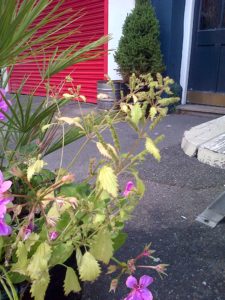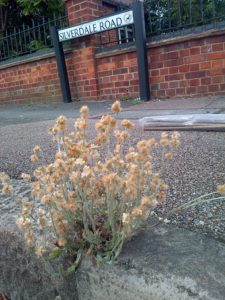Kent Botanical Recording Group’s 2016 edition of ‘Kent Botany’, compiled by Geoffrey Kitchener and detailing the most interesting and important finds during the year, includes a number of discoveries made in Bexley – which for botanical purposes falls within Vice-county 16, West Kent, and is therefore studied by both Kent and London botanists. Relevant extracts are reproduced below. The full document is available on our http://www.bexleywildlife.org/plants-bexley/ page.
Cotoneaster hjelmqvistii (Hjelmqvist’s Cotoneaster) was found in Blendon on a LNHS meeting led by Rodney Burton.
Cyclamen repandum (Spring Sowbread). For a successive year, we have a West Kent record for this relatively seldom naturalised species, a patch 3 x 3m at the east edge of Bexley Park Wood, seen by an LNHS meeting on 30 April.
Erigeron glaucus (Seaside Daisy) was found by Chris Rose on 14 March in an unusual habitat, by the A2 crash barrier between Penn Lane and Bexleyheath Golf Course, TQ 48056 74312.
Euphorbia corallioides (Coral Spurge) is an introduced spurge. A small group of plants was seen by Rodney on 16 July across the road from 18 Longleigh Lane, cited as ‘Bexleyheath’, where there is the scrubby grassland of Bostall Heath. This appears to be a first record for vice county 16, West Kent. It is not clear whether this was in Bexley or just over the border.
Gnaphalium luteoalbum (Jersey Cudweed) continues its Kentish spread as an urban weed primarily in metropolitan West Kent, belying its rare plant register status derived from possibly non-anthropogenic spread to damp sandy/gravelly habitats. It was seen by Chris Rose on 3 September as a street weed at Silverdale Road, Bexleyheath, TQ 49719 77391; and on 25 October in front garden paving at Parkside Avenue, Barnehurst, TQ 50731 76099, and near the junction of that road and Old Manor Way, TQ 50651 76087. Rodney Burton recorded it on 16 July on brick paving at 133 Gipsy Road and on crazy paving at no.135, Bexleyheath, TQ 4759 7613; on 27 July in paving blocks in front of 180 Glenesk Road, Eltham, and on 18 August on the pavement at 25-31 Castlefields, Istead Rise. Mike Robinson also noted a handful of plants beside a residential road, Barry Avenue near its junction with Cumberland Drive, Bexley, TQ 48229 77391, on 17 May.
Moenchia erecta (Upright Chickweed) is now treated as Vulnerable to the risk of extinction in England. The Kent position does not seem quite so alarming, and is improved by Rodney Burton discovering it on 14 May at a new site at Hall Place north, Bexley. At TQ 499 746 and TQ 499 747, there were six or more densely populated patches; and the species was also present at TQ 501 746 on the steepest part of hill and from TQ 5011 7470 to the west boundary of the hectad. That the species has escaped detection here for so long must be due to its inconspicuous nature.
Oxalis stricta (Upright Yellow-sorrel) has hardly any recent West Kent records and, whilst that position may be comforting to those concerned with its reputation as one of invasive species, it has now been reported from Sidcup station cycle park, TQ 4632 7263, seen by Rodney Burton on 28 May.
Persicaria capitata (Pink-headed Persicaria) is one of the less invasive garden Persicaria species, because not fully hardy in Britain, but it nonetheless occasionally escapes. It was seen by Chris Rose on 27 October around the Wellbeing Centre, Mill Road, Northumberland Heath, TQ 5021 577143, where it backs onto a car park, to which it had appeared to escape, under a fence, from a side passage of the adjoining house, 7 Mill Road. SP & DG also found it on a small piece of waste ground in a housing estate at south Strood, TQ7268. Otherwise, records in West Kent appear limited to three without comment on status (and so could have been in gardens) and (comm. Rodney Burton) a pavement weed record from Bexley Town in 1999.
Polycarpon tetraphyllum (Four-leaved Allseed) is now beginning to appear as a metropolitan street weed, in similar habitats as with Sagina spp., which could transform its distribution. The nationally rare status which supports its inclusion in the rare plant register can only be maintained by excluding its recent expansion in south east England. It was seen by Rodney Burton in the course of an LNHS meeting on 13 March at Pagnell Street, New Cross, TQ3677 at the top of a kerb near a gate signed as not to be obstructed (this would appear to place it at TQ 3655 7732). This seems to be a first record for West Kent, vice county 16. On 16 July, Rodney also came across several plants on crazy paving at 173 Gipsy Road, Bexleyheath, TQ 4762 7630; and on 27 July between paving blocks of forecourts of 146 and 150 Glenesk Road, Eltham, TQ4375.
Potentilla tabernaemontani (Spring Cinquefoil) is generally absent from south east England; there is a Hampshire population on chalk, but its native status has been doubted. There is no doubt that the four or so plants found in 24 the course of an LNHS meeting on 30 April (comm. Rodney Burton) were not native, these being on a grassy spot at a path edge nearest 61 Camden Road, Bexley, TQ 48506 73306, but not particularly near a garden. They were probably the cultivar ‘Nana’, generally commended for rock gardens.
Rumex maritimus (Golden Dock) and Rumex palustris (Marsh Dock), det. GK, both appeared by the dried up margin of a water feature which was part of the former Thamesview Golf Course, Thamesmead, closed down in 2014 and left to run wild. These were discovered by Mike Robinson, seven R. maritimus plants being noted at TQ 48159 80995 over the period 29 July to 10 August, and ten R. palustris being seen at TQ 48112 80918. Either of these, especially R. maritimus, would have been unusual records for metropolitan vc16. For both of them to occur together is exceptional. It is likely that these species are spread by wildfowl, but may not have the opportunity of germinating without changes in water levels.
Salix x ehrhartiana (the cross between White Willow and Bay Willow) is regarded as almost always planted in Britain (an introduced-survivor, in Stace (2010) terminology), and then only as a male tree. At the LNHS meeting of 30 April, Rodney Burton recorded an old tree, some 20m tall, with male catkins and young leaves, formerly in parkland near the edge of Bexley Park Wood (hornbeam coppice woodland), now as a result of development, next to modern fenced-in building, TQ 4819 7372. There is obvious difficulty in evaluating its status, and the likelihood must be of a planted origin; indeed, the only clear evidence of an unplanted origin would require the observation of rooted twigs in the vicinity of a planted tree. The current find would be a first record for vice county 16, West Kent, if we were applying more relaxed status criteria for ‘first records’.
Urtica membranacea was recorded by Chris Rose (confirmed by Rodney Burton) on 3 September at Bexleyheath, where a single plant was present in a planter outside the Prince Albert public house at the end of Erith Road opposite the top of Gravel Hill, TQ49662 75140. This Mediterranean species has begun appearing in urban habitats in England, such as plant containers and street-sides and this sighting represents a first record for vice county 16, West Kent.

Urtica membranacea, outside the Prince Albert pub opposite the Council offices in Bexleyheath, 3/9/2016. (Photo: Chris Rose)
Chris Rose


